Photographic History: Critical Review, Modernism, Postmodernism, Visual Analysis
VerifiedAdded on 2023/06/15
|11
|2721
|379
AI Summary
This article explores the critical review of photographic history, modernism, postmodernism, and visual analysis of photographs by Tina Modotti and Vivian Maier.
Contribute Materials
Your contribution can guide someone’s learning journey. Share your
documents today.

Running head: PHOTOGRAPHIC HISTORY
Photographic History
Student Name
University name
Author Name
Photographic History
Student Name
University name
Author Name
Secure Best Marks with AI Grader
Need help grading? Try our AI Grader for instant feedback on your assignments.

PHOTOGRAPHIC HISTORY
Task 1: Critical Review:
Semiology is the study of signs. Roland Barthes introduced this idea, modifying the
theories suggested by Ferdinand de Saussure in linguistics as an underdeveloped area of science
related to signs and signification. This system of signs can be interpreted in other forms music,
entertainment and photographic language. The relational value of signs can be established
through this powerful tool named semiology (Pearson, 2015). This is significantly effective when
the readers or the spectators fail to interpret the deeper meaning of the text. Not only the creator's
ideology, but the semiology also brings various social aspects to the surface. It is general practice
for the viewers to interpret the artistic expression in a very literal sense, but semiology brings out
the deeper meaning that was hidden underneath (Kiefer, 2015). In the process, it might bring out
the ugly truth by penetrating the beautifies superficial surface. However, it should also be
considered that out social understanding often shapes the interpretation. The relationship that
photograph establishes with the objects is quite different from other art forms as it corresponds
with its representation and that is why Charles Sanders called photography as a referent (Robins,
2014).
Barthes explained sign as a complex relationship between signifier and signified
(Chandler, 2017). The signifier is the object through which the idea or signified is expressed. The
example has been used to highlight the meaning of signifier and signified is a red ketchup bottle.
The signified here is the ketchup like this that you built through your experience. The signifier is
that is not any other sauce than the specific red ketchup. Barthes also talked about denotation or
the literal meaning of sign that acts as the first level of signification and the connotation is
understanding the meaning beyond the denotation (Yan & Ming, 2015).
Task 1: Critical Review:
Semiology is the study of signs. Roland Barthes introduced this idea, modifying the
theories suggested by Ferdinand de Saussure in linguistics as an underdeveloped area of science
related to signs and signification. This system of signs can be interpreted in other forms music,
entertainment and photographic language. The relational value of signs can be established
through this powerful tool named semiology (Pearson, 2015). This is significantly effective when
the readers or the spectators fail to interpret the deeper meaning of the text. Not only the creator's
ideology, but the semiology also brings various social aspects to the surface. It is general practice
for the viewers to interpret the artistic expression in a very literal sense, but semiology brings out
the deeper meaning that was hidden underneath (Kiefer, 2015). In the process, it might bring out
the ugly truth by penetrating the beautifies superficial surface. However, it should also be
considered that out social understanding often shapes the interpretation. The relationship that
photograph establishes with the objects is quite different from other art forms as it corresponds
with its representation and that is why Charles Sanders called photography as a referent (Robins,
2014).
Barthes explained sign as a complex relationship between signifier and signified
(Chandler, 2017). The signifier is the object through which the idea or signified is expressed. The
example has been used to highlight the meaning of signifier and signified is a red ketchup bottle.
The signified here is the ketchup like this that you built through your experience. The signifier is
that is not any other sauce than the specific red ketchup. Barthes also talked about denotation or
the literal meaning of sign that acts as the first level of signification and the connotation is
understanding the meaning beyond the denotation (Yan & Ming, 2015).
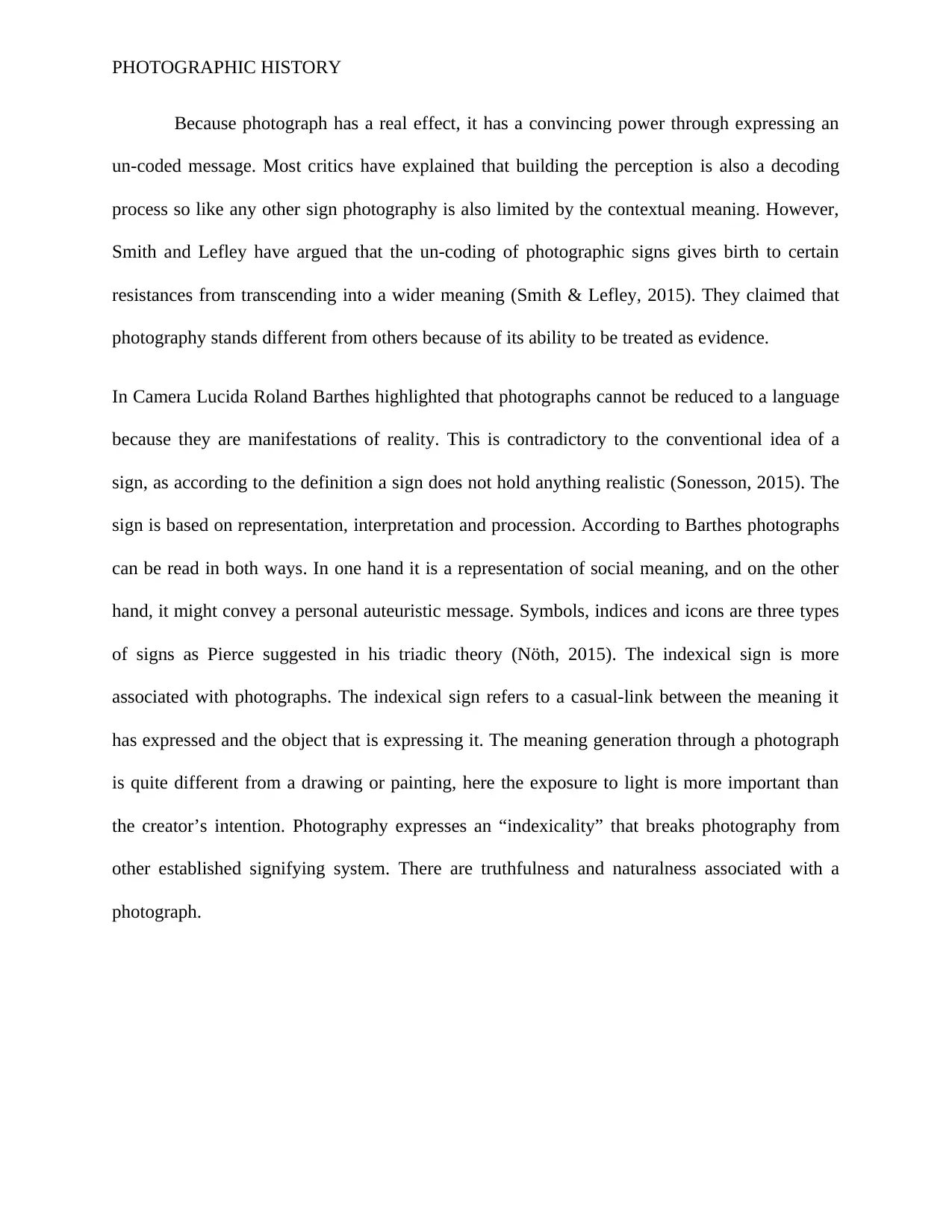
PHOTOGRAPHIC HISTORY
Because photograph has a real effect, it has a convincing power through expressing an
un-coded message. Most critics have explained that building the perception is also a decoding
process so like any other sign photography is also limited by the contextual meaning. However,
Smith and Lefley have argued that the un-coding of photographic signs gives birth to certain
resistances from transcending into a wider meaning (Smith & Lefley, 2015). They claimed that
photography stands different from others because of its ability to be treated as evidence.
In Camera Lucida Roland Barthes highlighted that photographs cannot be reduced to a language
because they are manifestations of reality. This is contradictory to the conventional idea of a
sign, as according to the definition a sign does not hold anything realistic (Sonesson, 2015). The
sign is based on representation, interpretation and procession. According to Barthes photographs
can be read in both ways. In one hand it is a representation of social meaning, and on the other
hand, it might convey a personal auteuristic message. Symbols, indices and icons are three types
of signs as Pierce suggested in his triadic theory (Nöth, 2015). The indexical sign is more
associated with photographs. The indexical sign refers to a casual-link between the meaning it
has expressed and the object that is expressing it. The meaning generation through a photograph
is quite different from a drawing or painting, here the exposure to light is more important than
the creator’s intention. Photography expresses an “indexicality” that breaks photography from
other established signifying system. There are truthfulness and naturalness associated with a
photograph.
Because photograph has a real effect, it has a convincing power through expressing an
un-coded message. Most critics have explained that building the perception is also a decoding
process so like any other sign photography is also limited by the contextual meaning. However,
Smith and Lefley have argued that the un-coding of photographic signs gives birth to certain
resistances from transcending into a wider meaning (Smith & Lefley, 2015). They claimed that
photography stands different from others because of its ability to be treated as evidence.
In Camera Lucida Roland Barthes highlighted that photographs cannot be reduced to a language
because they are manifestations of reality. This is contradictory to the conventional idea of a
sign, as according to the definition a sign does not hold anything realistic (Sonesson, 2015). The
sign is based on representation, interpretation and procession. According to Barthes photographs
can be read in both ways. In one hand it is a representation of social meaning, and on the other
hand, it might convey a personal auteuristic message. Symbols, indices and icons are three types
of signs as Pierce suggested in his triadic theory (Nöth, 2015). The indexical sign is more
associated with photographs. The indexical sign refers to a casual-link between the meaning it
has expressed and the object that is expressing it. The meaning generation through a photograph
is quite different from a drawing or painting, here the exposure to light is more important than
the creator’s intention. Photography expresses an “indexicality” that breaks photography from
other established signifying system. There are truthfulness and naturalness associated with a
photograph.
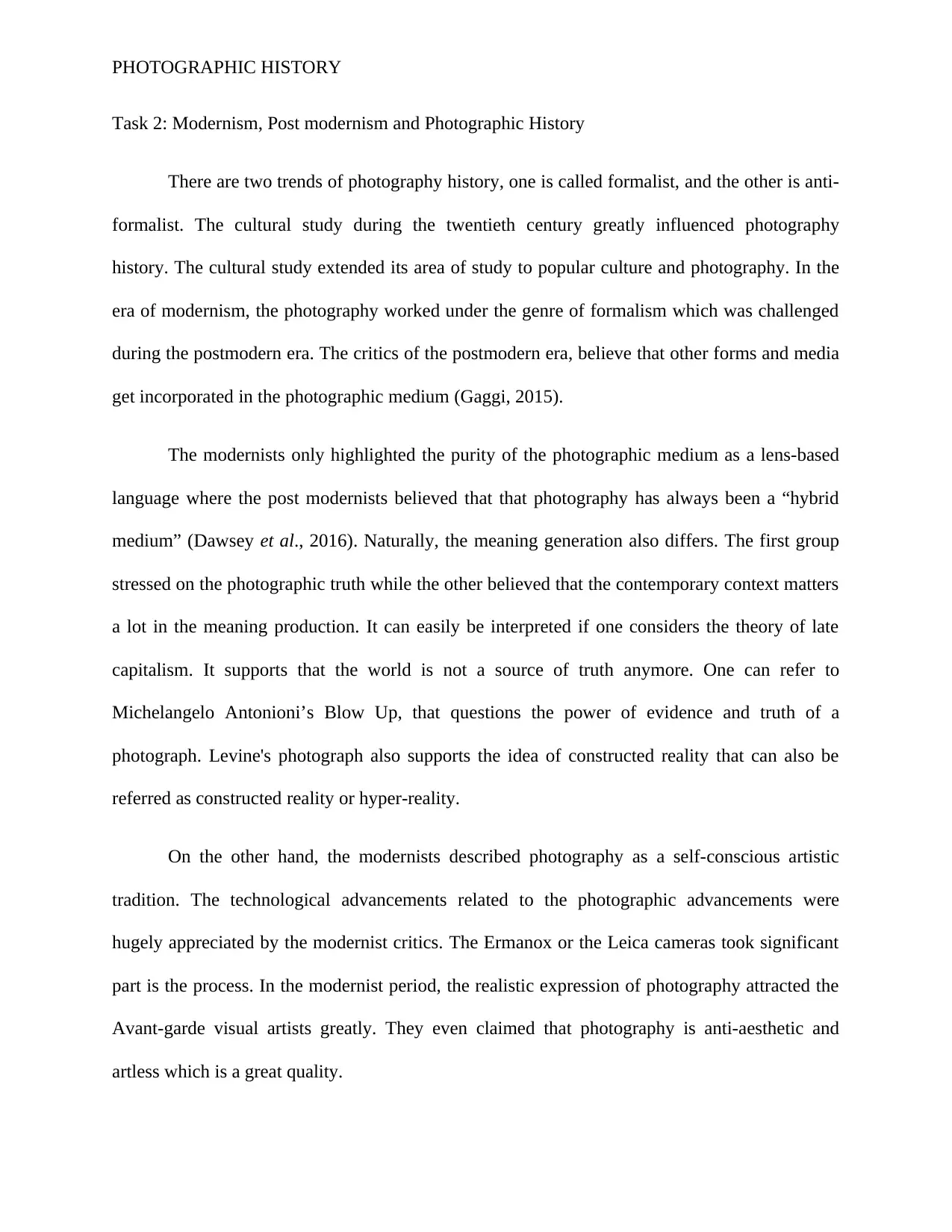
PHOTOGRAPHIC HISTORY
Task 2: Modernism, Post modernism and Photographic History
There are two trends of photography history, one is called formalist, and the other is anti-
formalist. The cultural study during the twentieth century greatly influenced photography
history. The cultural study extended its area of study to popular culture and photography. In the
era of modernism, the photography worked under the genre of formalism which was challenged
during the postmodern era. The critics of the postmodern era, believe that other forms and media
get incorporated in the photographic medium (Gaggi, 2015).
The modernists only highlighted the purity of the photographic medium as a lens-based
language where the post modernists believed that that photography has always been a “hybrid
medium” (Dawsey et al., 2016). Naturally, the meaning generation also differs. The first group
stressed on the photographic truth while the other believed that the contemporary context matters
a lot in the meaning production. It can easily be interpreted if one considers the theory of late
capitalism. It supports that the world is not a source of truth anymore. One can refer to
Michelangelo Antonioni’s Blow Up, that questions the power of evidence and truth of a
photograph. Levine's photograph also supports the idea of constructed reality that can also be
referred as constructed reality or hyper-reality.
On the other hand, the modernists described photography as a self-conscious artistic
tradition. The technological advancements related to the photographic advancements were
hugely appreciated by the modernist critics. The Ermanox or the Leica cameras took significant
part is the process. In the modernist period, the realistic expression of photography attracted the
Avant-garde visual artists greatly. They even claimed that photography is anti-aesthetic and
artless which is a great quality.
Task 2: Modernism, Post modernism and Photographic History
There are two trends of photography history, one is called formalist, and the other is anti-
formalist. The cultural study during the twentieth century greatly influenced photography
history. The cultural study extended its area of study to popular culture and photography. In the
era of modernism, the photography worked under the genre of formalism which was challenged
during the postmodern era. The critics of the postmodern era, believe that other forms and media
get incorporated in the photographic medium (Gaggi, 2015).
The modernists only highlighted the purity of the photographic medium as a lens-based
language where the post modernists believed that that photography has always been a “hybrid
medium” (Dawsey et al., 2016). Naturally, the meaning generation also differs. The first group
stressed on the photographic truth while the other believed that the contemporary context matters
a lot in the meaning production. It can easily be interpreted if one considers the theory of late
capitalism. It supports that the world is not a source of truth anymore. One can refer to
Michelangelo Antonioni’s Blow Up, that questions the power of evidence and truth of a
photograph. Levine's photograph also supports the idea of constructed reality that can also be
referred as constructed reality or hyper-reality.
On the other hand, the modernists described photography as a self-conscious artistic
tradition. The technological advancements related to the photographic advancements were
hugely appreciated by the modernist critics. The Ermanox or the Leica cameras took significant
part is the process. In the modernist period, the realistic expression of photography attracted the
Avant-garde visual artists greatly. They even claimed that photography is anti-aesthetic and
artless which is a great quality.
Secure Best Marks with AI Grader
Need help grading? Try our AI Grader for instant feedback on your assignments.

PHOTOGRAPHIC HISTORY
Formalism is most associated with the first kind of avant-garde which mainly highlights
the formal properties of photography. This is apparent that this formalist experience separates
any artistic experience associated with contemporary society, life and history. The modernist
claimed photography to be an autonomous medium and belongs to a completely separate space.
Postmodernists said photography is associated with all institutions and disciplines. As Batchen
referred photography is nothing but a misleading fiction with no identity of its own (Elkins,
2013).
The formalist approach is more focused on searching the nature of the photography and
the anti-formalists fight to establish its dependent nature which is without any definite identity.
The second group believes that photography resides in a world that is ever-changing. The
ideological construction of photographic history has always been open to oppositions. The
photography history is still an underexplored area of study. Many areas are significantly
neglected like its recreational power and the application in communication industries. The
consumerism and social stereotyping have been worsening the situation. Modernism and
postmodernism inform the photographic practice differently, but this opposition makes the
medium so interesting.
Formalism is most associated with the first kind of avant-garde which mainly highlights
the formal properties of photography. This is apparent that this formalist experience separates
any artistic experience associated with contemporary society, life and history. The modernist
claimed photography to be an autonomous medium and belongs to a completely separate space.
Postmodernists said photography is associated with all institutions and disciplines. As Batchen
referred photography is nothing but a misleading fiction with no identity of its own (Elkins,
2013).
The formalist approach is more focused on searching the nature of the photography and
the anti-formalists fight to establish its dependent nature which is without any definite identity.
The second group believes that photography resides in a world that is ever-changing. The
ideological construction of photographic history has always been open to oppositions. The
photography history is still an underexplored area of study. Many areas are significantly
neglected like its recreational power and the application in communication industries. The
consumerism and social stereotyping have been worsening the situation. Modernism and
postmodernism inform the photographic practice differently, but this opposition makes the
medium so interesting.
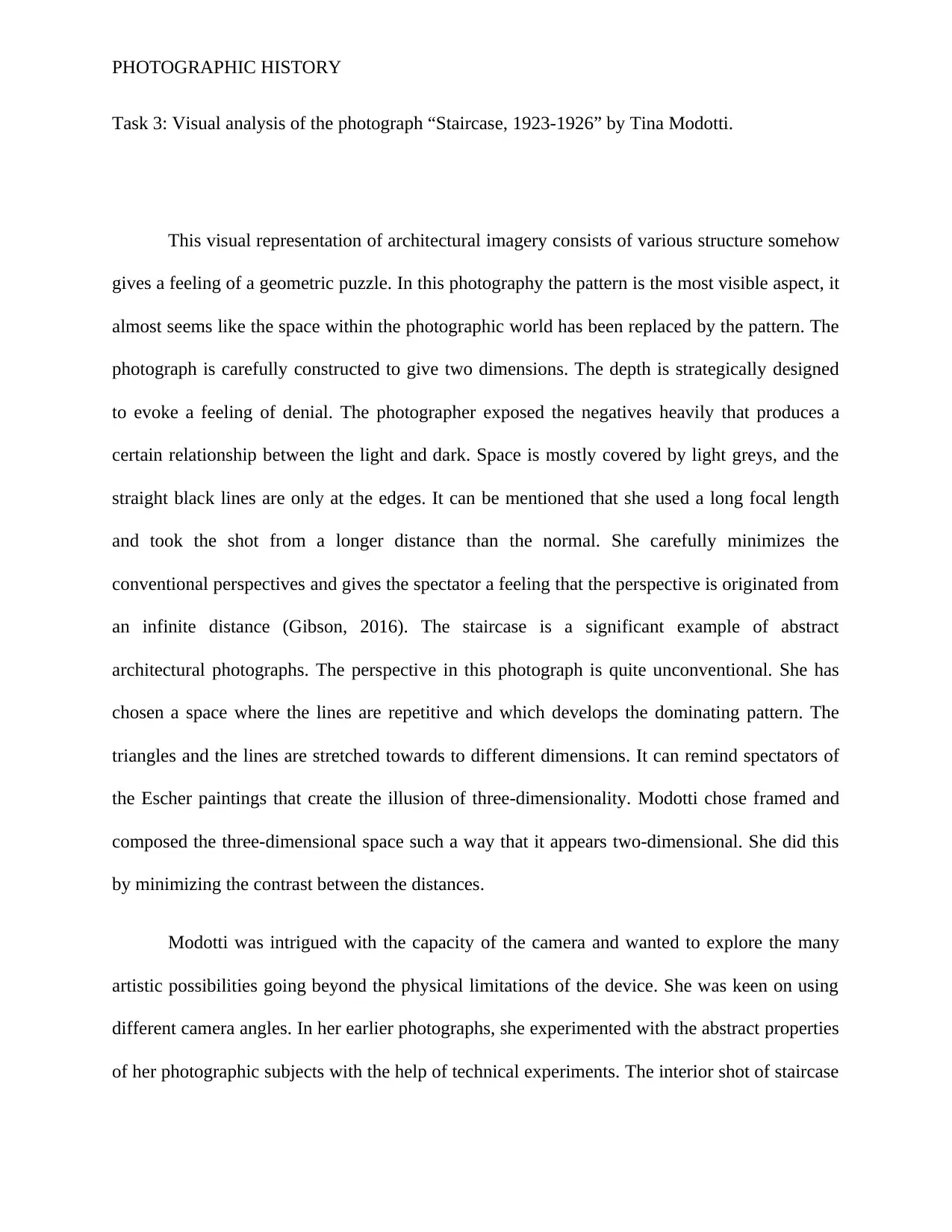
PHOTOGRAPHIC HISTORY
Task 3: Visual analysis of the photograph “Staircase, 1923-1926” by Tina Modotti.
This visual representation of architectural imagery consists of various structure somehow
gives a feeling of a geometric puzzle. In this photography the pattern is the most visible aspect, it
almost seems like the space within the photographic world has been replaced by the pattern. The
photograph is carefully constructed to give two dimensions. The depth is strategically designed
to evoke a feeling of denial. The photographer exposed the negatives heavily that produces a
certain relationship between the light and dark. Space is mostly covered by light greys, and the
straight black lines are only at the edges. It can be mentioned that she used a long focal length
and took the shot from a longer distance than the normal. She carefully minimizes the
conventional perspectives and gives the spectator a feeling that the perspective is originated from
an infinite distance (Gibson, 2016). The staircase is a significant example of abstract
architectural photographs. The perspective in this photograph is quite unconventional. She has
chosen a space where the lines are repetitive and which develops the dominating pattern. The
triangles and the lines are stretched towards to different dimensions. It can remind spectators of
the Escher paintings that create the illusion of three-dimensionality. Modotti chose framed and
composed the three-dimensional space such a way that it appears two-dimensional. She did this
by minimizing the contrast between the distances.
Modotti was intrigued with the capacity of the camera and wanted to explore the many
artistic possibilities going beyond the physical limitations of the device. She was keen on using
different camera angles. In her earlier photographs, she experimented with the abstract properties
of her photographic subjects with the help of technical experiments. The interior shot of staircase
Task 3: Visual analysis of the photograph “Staircase, 1923-1926” by Tina Modotti.
This visual representation of architectural imagery consists of various structure somehow
gives a feeling of a geometric puzzle. In this photography the pattern is the most visible aspect, it
almost seems like the space within the photographic world has been replaced by the pattern. The
photograph is carefully constructed to give two dimensions. The depth is strategically designed
to evoke a feeling of denial. The photographer exposed the negatives heavily that produces a
certain relationship between the light and dark. Space is mostly covered by light greys, and the
straight black lines are only at the edges. It can be mentioned that she used a long focal length
and took the shot from a longer distance than the normal. She carefully minimizes the
conventional perspectives and gives the spectator a feeling that the perspective is originated from
an infinite distance (Gibson, 2016). The staircase is a significant example of abstract
architectural photographs. The perspective in this photograph is quite unconventional. She has
chosen a space where the lines are repetitive and which develops the dominating pattern. The
triangles and the lines are stretched towards to different dimensions. It can remind spectators of
the Escher paintings that create the illusion of three-dimensionality. Modotti chose framed and
composed the three-dimensional space such a way that it appears two-dimensional. She did this
by minimizing the contrast between the distances.
Modotti was intrigued with the capacity of the camera and wanted to explore the many
artistic possibilities going beyond the physical limitations of the device. She was keen on using
different camera angles. In her earlier photographs, she experimented with the abstract properties
of her photographic subjects with the help of technical experiments. The interior shot of staircase
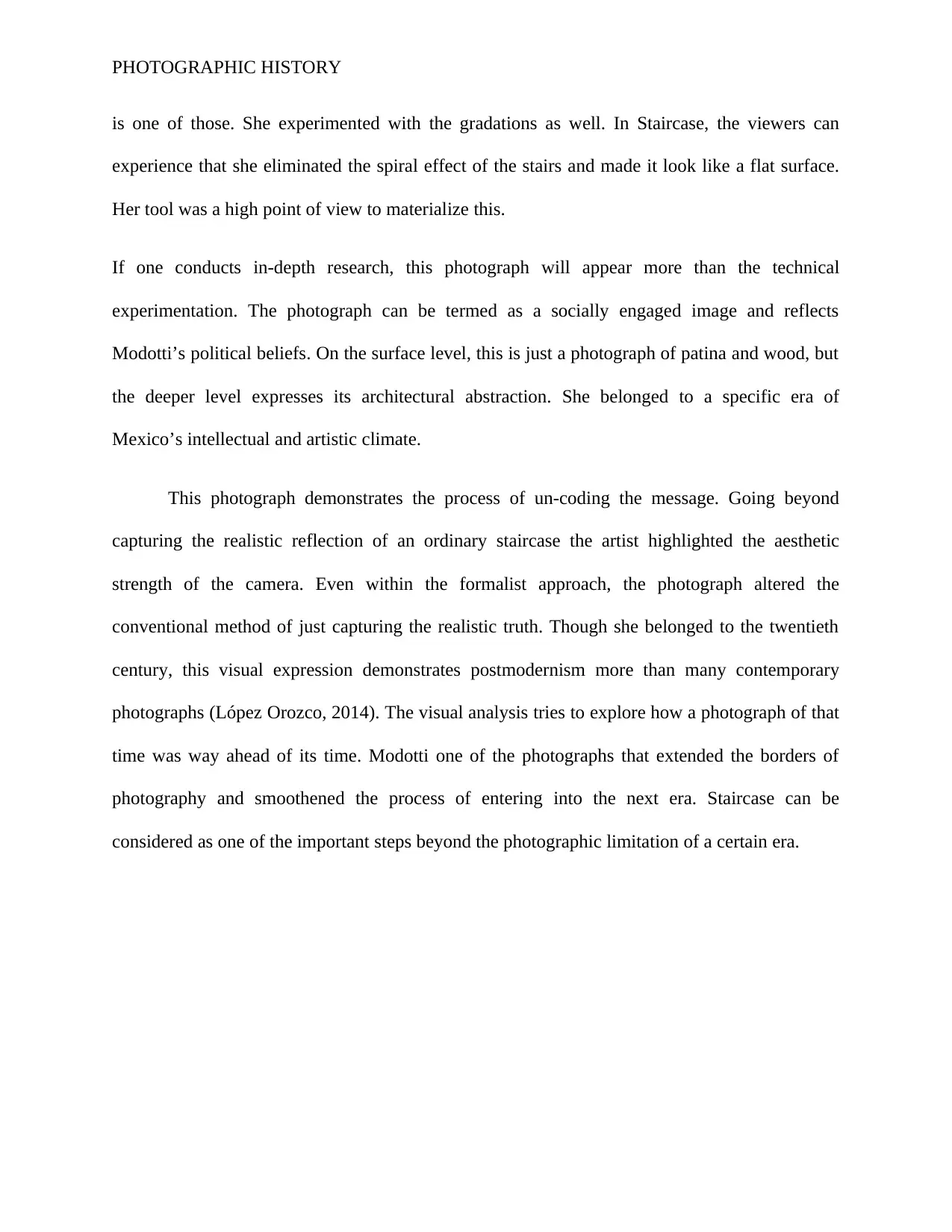
PHOTOGRAPHIC HISTORY
is one of those. She experimented with the gradations as well. In Staircase, the viewers can
experience that she eliminated the spiral effect of the stairs and made it look like a flat surface.
Her tool was a high point of view to materialize this.
If one conducts in-depth research, this photograph will appear more than the technical
experimentation. The photograph can be termed as a socially engaged image and reflects
Modotti’s political beliefs. On the surface level, this is just a photograph of patina and wood, but
the deeper level expresses its architectural abstraction. She belonged to a specific era of
Mexico’s intellectual and artistic climate.
This photograph demonstrates the process of un-coding the message. Going beyond
capturing the realistic reflection of an ordinary staircase the artist highlighted the aesthetic
strength of the camera. Even within the formalist approach, the photograph altered the
conventional method of just capturing the realistic truth. Though she belonged to the twentieth
century, this visual expression demonstrates postmodernism more than many contemporary
photographs (López Orozco, 2014). The visual analysis tries to explore how a photograph of that
time was way ahead of its time. Modotti one of the photographs that extended the borders of
photography and smoothened the process of entering into the next era. Staircase can be
considered as one of the important steps beyond the photographic limitation of a certain era.
is one of those. She experimented with the gradations as well. In Staircase, the viewers can
experience that she eliminated the spiral effect of the stairs and made it look like a flat surface.
Her tool was a high point of view to materialize this.
If one conducts in-depth research, this photograph will appear more than the technical
experimentation. The photograph can be termed as a socially engaged image and reflects
Modotti’s political beliefs. On the surface level, this is just a photograph of patina and wood, but
the deeper level expresses its architectural abstraction. She belonged to a specific era of
Mexico’s intellectual and artistic climate.
This photograph demonstrates the process of un-coding the message. Going beyond
capturing the realistic reflection of an ordinary staircase the artist highlighted the aesthetic
strength of the camera. Even within the formalist approach, the photograph altered the
conventional method of just capturing the realistic truth. Though she belonged to the twentieth
century, this visual expression demonstrates postmodernism more than many contemporary
photographs (López Orozco, 2014). The visual analysis tries to explore how a photograph of that
time was way ahead of its time. Modotti one of the photographs that extended the borders of
photography and smoothened the process of entering into the next era. Staircase can be
considered as one of the important steps beyond the photographic limitation of a certain era.
Paraphrase This Document
Need a fresh take? Get an instant paraphrase of this document with our AI Paraphraser

PHOTOGRAPHIC HISTORY
Task 4: Visual Analysis of a street image by Vivian Maier
Vivian Maier is a photographer who took more than 150,000 street images (Bannos,
2017). The photos may appear just slices of street life on the surface, but each photograph tells a
story and a hidden history. Her photographs celebrated the people from the streets, people on the
streets, the streets who were often ignored by the most contemporary artists. She celebrated those
ignored subjects, those people make the life so realistic, so alive. These subjects have always
been at the peripheral and they are called the etceteras. These etceteras are dominating the
photographic space of Vivian Maier’s creation. Long before those social experiments on social
media like Humans of America, Vivian brought them to the surface.
The photograph that has been chosen for this discussion has five African American
children expressing joy. It is noticeable that her characters are often directly addressing the
camera. They are developing a relationship with the photographer and through the camera to the
viewers. The image separates itself from the photographer and removes the baggage any average
photograph carries. When a photograph goes beyond the artist's limitation, it becomes a piece of
true art and when the artist develops her style, she becomes an auteur. Vivian Maier is no less
than the photographer auteur. In this photograph, one can see that five children are excited for
some reason and they are expressing their joy. The photographer has captured this moment
without any designed composition. The characters are at the canter and capturing most of the
space. They are not posing for the camera and the reality is not constructed. The subjects are
children and Vivian spend most of her life as a nanny. One can see how successfully the camera
captures the innocence, the pure joy. The photograph tells an alternate history to its audience.
This has a political connotation, but it is not directly related to the American history of racism.
The political statement is inside the photographic form itself. The protest is against the
Task 4: Visual Analysis of a street image by Vivian Maier
Vivian Maier is a photographer who took more than 150,000 street images (Bannos,
2017). The photos may appear just slices of street life on the surface, but each photograph tells a
story and a hidden history. Her photographs celebrated the people from the streets, people on the
streets, the streets who were often ignored by the most contemporary artists. She celebrated those
ignored subjects, those people make the life so realistic, so alive. These subjects have always
been at the peripheral and they are called the etceteras. These etceteras are dominating the
photographic space of Vivian Maier’s creation. Long before those social experiments on social
media like Humans of America, Vivian brought them to the surface.
The photograph that has been chosen for this discussion has five African American
children expressing joy. It is noticeable that her characters are often directly addressing the
camera. They are developing a relationship with the photographer and through the camera to the
viewers. The image separates itself from the photographer and removes the baggage any average
photograph carries. When a photograph goes beyond the artist's limitation, it becomes a piece of
true art and when the artist develops her style, she becomes an auteur. Vivian Maier is no less
than the photographer auteur. In this photograph, one can see that five children are excited for
some reason and they are expressing their joy. The photographer has captured this moment
without any designed composition. The characters are at the canter and capturing most of the
space. They are not posing for the camera and the reality is not constructed. The subjects are
children and Vivian spend most of her life as a nanny. One can see how successfully the camera
captures the innocence, the pure joy. The photograph tells an alternate history to its audience.
This has a political connotation, but it is not directly related to the American history of racism.
The political statement is inside the photographic form itself. The protest is against the
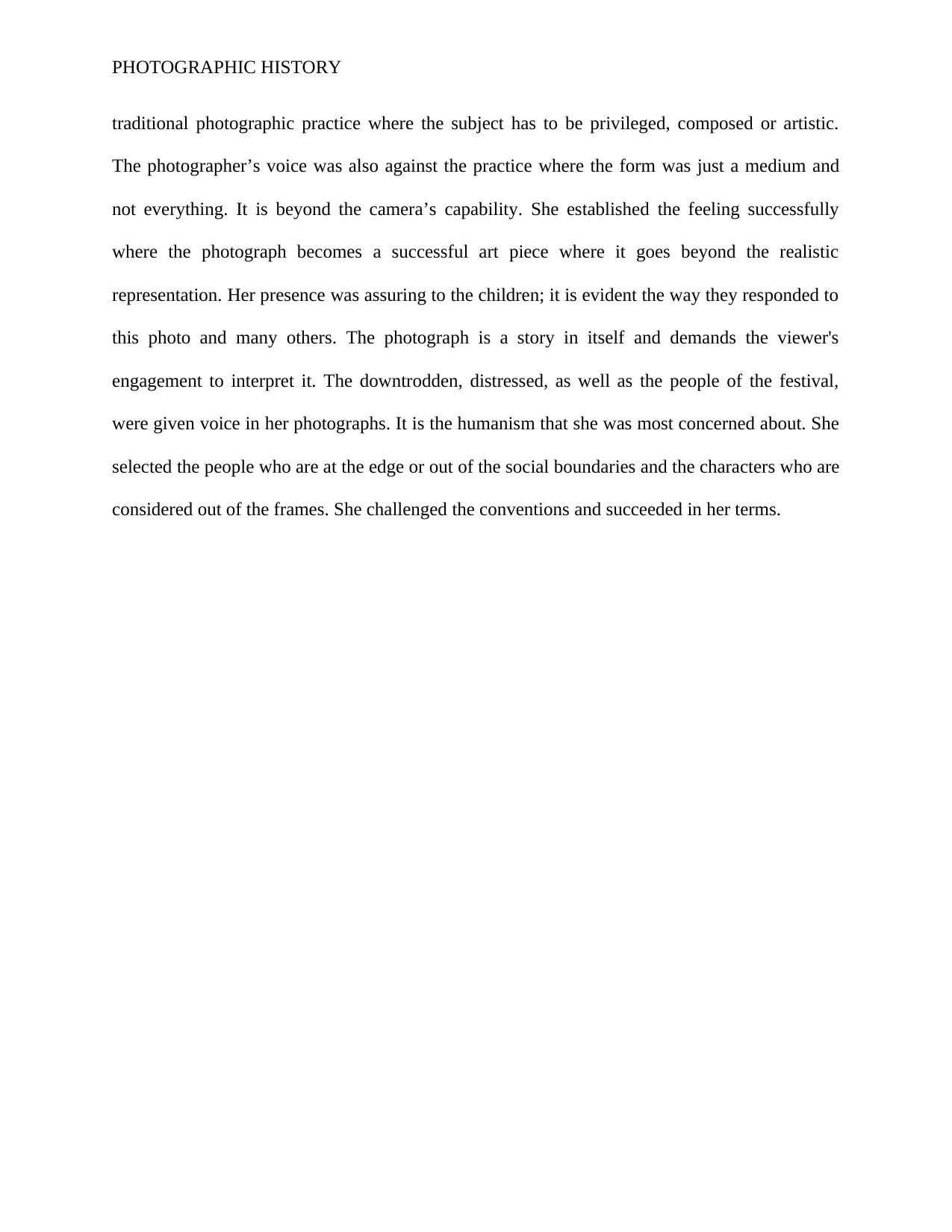
PHOTOGRAPHIC HISTORY
traditional photographic practice where the subject has to be privileged, composed or artistic.
The photographer’s voice was also against the practice where the form was just a medium and
not everything. It is beyond the camera’s capability. She established the feeling successfully
where the photograph becomes a successful art piece where it goes beyond the realistic
representation. Her presence was assuring to the children; it is evident the way they responded to
this photo and many others. The photograph is a story in itself and demands the viewer's
engagement to interpret it. The downtrodden, distressed, as well as the people of the festival,
were given voice in her photographs. It is the humanism that she was most concerned about. She
selected the people who are at the edge or out of the social boundaries and the characters who are
considered out of the frames. She challenged the conventions and succeeded in her terms.
traditional photographic practice where the subject has to be privileged, composed or artistic.
The photographer’s voice was also against the practice where the form was just a medium and
not everything. It is beyond the camera’s capability. She established the feeling successfully
where the photograph becomes a successful art piece where it goes beyond the realistic
representation. Her presence was assuring to the children; it is evident the way they responded to
this photo and many others. The photograph is a story in itself and demands the viewer's
engagement to interpret it. The downtrodden, distressed, as well as the people of the festival,
were given voice in her photographs. It is the humanism that she was most concerned about. She
selected the people who are at the edge or out of the social boundaries and the characters who are
considered out of the frames. She challenged the conventions and succeeded in her terms.
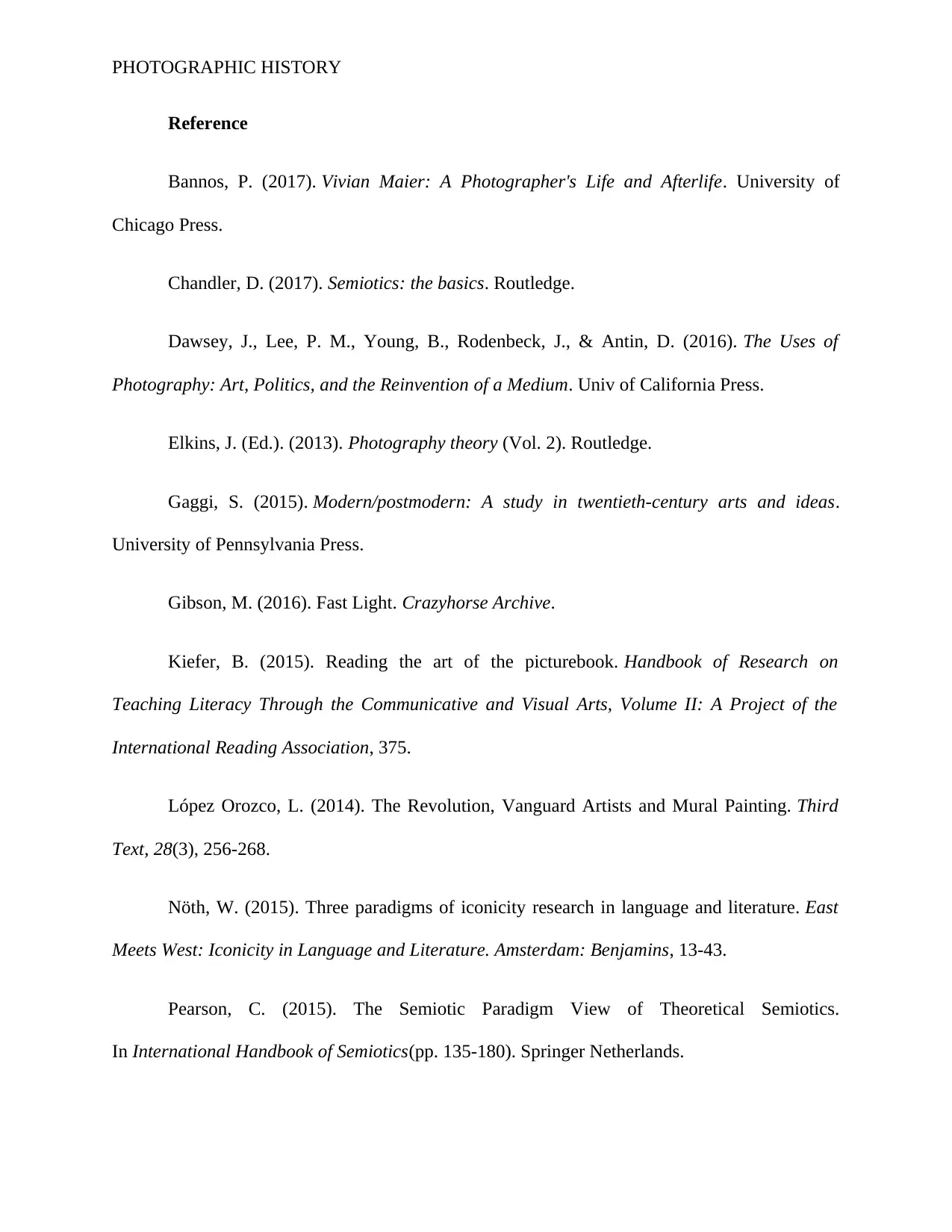
PHOTOGRAPHIC HISTORY
Reference
Bannos, P. (2017). Vivian Maier: A Photographer's Life and Afterlife. University of
Chicago Press.
Chandler, D. (2017). Semiotics: the basics. Routledge.
Dawsey, J., Lee, P. M., Young, B., Rodenbeck, J., & Antin, D. (2016). The Uses of
Photography: Art, Politics, and the Reinvention of a Medium. Univ of California Press.
Elkins, J. (Ed.). (2013). Photography theory (Vol. 2). Routledge.
Gaggi, S. (2015). Modern/postmodern: A study in twentieth-century arts and ideas.
University of Pennsylvania Press.
Gibson, M. (2016). Fast Light. Crazyhorse Archive.
Kiefer, B. (2015). Reading the art of the picturebook. Handbook of Research on
Teaching Literacy Through the Communicative and Visual Arts, Volume II: A Project of the
International Reading Association, 375.
López Orozco, L. (2014). The Revolution, Vanguard Artists and Mural Painting. Third
Text, 28(3), 256-268.
Nöth, W. (2015). Three paradigms of iconicity research in language and literature. East
Meets West: Iconicity in Language and Literature. Amsterdam: Benjamins, 13-43.
Pearson, C. (2015). The Semiotic Paradigm View of Theoretical Semiotics.
In International Handbook of Semiotics(pp. 135-180). Springer Netherlands.
Reference
Bannos, P. (2017). Vivian Maier: A Photographer's Life and Afterlife. University of
Chicago Press.
Chandler, D. (2017). Semiotics: the basics. Routledge.
Dawsey, J., Lee, P. M., Young, B., Rodenbeck, J., & Antin, D. (2016). The Uses of
Photography: Art, Politics, and the Reinvention of a Medium. Univ of California Press.
Elkins, J. (Ed.). (2013). Photography theory (Vol. 2). Routledge.
Gaggi, S. (2015). Modern/postmodern: A study in twentieth-century arts and ideas.
University of Pennsylvania Press.
Gibson, M. (2016). Fast Light. Crazyhorse Archive.
Kiefer, B. (2015). Reading the art of the picturebook. Handbook of Research on
Teaching Literacy Through the Communicative and Visual Arts, Volume II: A Project of the
International Reading Association, 375.
López Orozco, L. (2014). The Revolution, Vanguard Artists and Mural Painting. Third
Text, 28(3), 256-268.
Nöth, W. (2015). Three paradigms of iconicity research in language and literature. East
Meets West: Iconicity in Language and Literature. Amsterdam: Benjamins, 13-43.
Pearson, C. (2015). The Semiotic Paradigm View of Theoretical Semiotics.
In International Handbook of Semiotics(pp. 135-180). Springer Netherlands.
Secure Best Marks with AI Grader
Need help grading? Try our AI Grader for instant feedback on your assignments.

PHOTOGRAPHIC HISTORY
Robins, A. (2014). Peirce and Photography: Art, Semiotics, and Science. The Journal of
Speculative Philosophy, 28(1), 1-16.
Smith, P., & Lefley, C. (2015). Rethinking Photography: histories, Theories and
education. Routledge.
Sonesson, G. (2015). Semiotics of photography: The state of the art. In International
handbook of semiotics (pp. 417-483). Springer Netherlands.
Yan, S., & Ming, F. (2015). Reinterpreting some key concepts in Barthes' theory. Journal
of Media and Communication Studies, 7(3), 59.
Robins, A. (2014). Peirce and Photography: Art, Semiotics, and Science. The Journal of
Speculative Philosophy, 28(1), 1-16.
Smith, P., & Lefley, C. (2015). Rethinking Photography: histories, Theories and
education. Routledge.
Sonesson, G. (2015). Semiotics of photography: The state of the art. In International
handbook of semiotics (pp. 417-483). Springer Netherlands.
Yan, S., & Ming, F. (2015). Reinterpreting some key concepts in Barthes' theory. Journal
of Media and Communication Studies, 7(3), 59.
1 out of 11
Your All-in-One AI-Powered Toolkit for Academic Success.
+13062052269
info@desklib.com
Available 24*7 on WhatsApp / Email
![[object Object]](/_next/static/media/star-bottom.7253800d.svg)
Unlock your academic potential
© 2024 | Zucol Services PVT LTD | All rights reserved.


